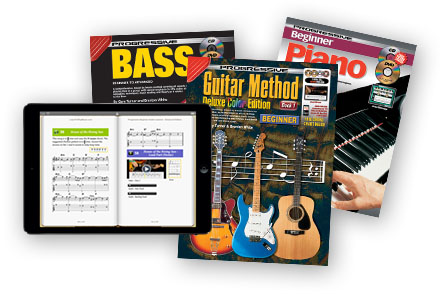<< First < Previous | Intro 1 2 3 4 5 | Next > Last >>
Back to Table of Contents
The C Major Chord
A chord is a group of three or more notes played together. Chords are used to accompany a singer, or an instrumentalist who is playing the melody of a song. The first chord you will learn is the C major chord, usually just called the C chord. The C major chord is indicated by the letter C. This is called the chord symbol.
Strumming
Play all four strings at the same time with your index finger, thumb or pick, using a downward motion. This is called a strum. Hold the pick lightly and strum from the wrist. Keep your wrist relaxed. If any notes buzz or sound deadened, you may have to press harder with the left hand fingers and make sure that your fingers are just behind the fret.
In the following example there are five bars of the C major chord played in  time. The chord symbol is written above the staff and is placed at the beginning of each bar. Play the chord with four quarter note strums in each bar. To make an example sound complete, always end with a whole note strum V of the first chord, shown at the end of this example.
time. The chord symbol is written above the staff and is placed at the beginning of each bar. Play the chord with four quarter note strums in each bar. To make an example sound complete, always end with a whole note strum V of the first chord, shown at the end of this example.
| 1 |
Video
Audio – Solo Track
Audio – Backing Track
The Seventh Chord
Another type of common chord is the dominant seventh chord. It is usually referred to as the seventh chord. The chord symbol for the seventh chord is the number 7 written after the alphabetical letter. The symbol for the G seventh chord is G7.
| 2 |
Video
Audio – Solo Track
Audio – Backing Track
Chord Progressions
The following example is called a chord progression, meaning a series of chord changes (in this case between C and G7). Chord progressions are common in all styles of music, and the more you know, the more songs you will be able to play. The two dots at the end of bar 4 are a repeat sign, telling you to play again from the start.
| 3 |
Video
Audio – Solo Track
Audio – Backing Track
Slide Finger
When changing from C to G7, do not lift your third finger off the first string, but slide it down to the second fret. Only touch the string very lightly as you slide along it. The use of the slide finger will make changing between C and G7 chords easier.
Rhythm Patterns
Instead of writing the strumming above each bar of music, it is easier to write it as a rhythm pattern. This indicates which strumming pattern to use in each bar throughout the song. The rhythm pattern above the following example shows four strums per bar, with each strum having the value of a quarter note. At the end of the song, play a final C chord and let it ring.
| 4 | Shortnin’ Bread |
Video
Audio – Solo Track
Audio – Backing Track
| 5 | Mary Ann |
This traditional Caribbean song also uses the chords C and G7 and sounds great on the ukulele. Remember to use the slide finger technique when changing chords.
| 5 | Mary Ann |
Video
Audio – Solo Track
Audio – Backing Track
<< First < Previous | Intro 1 2 3 4 5 | Next > Last >>
Back to Table of Contents













































